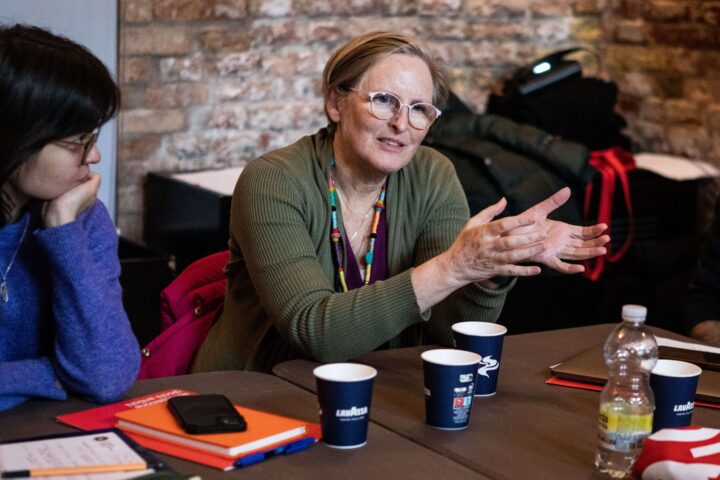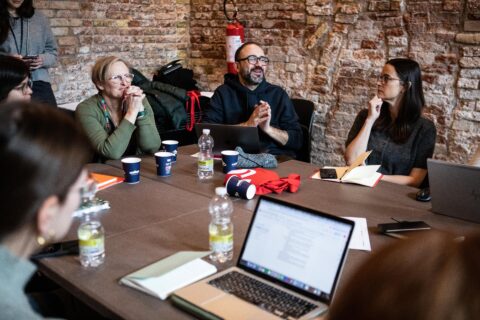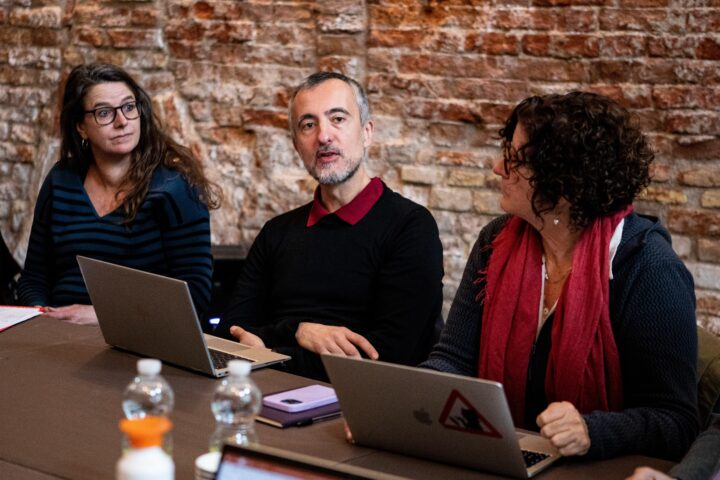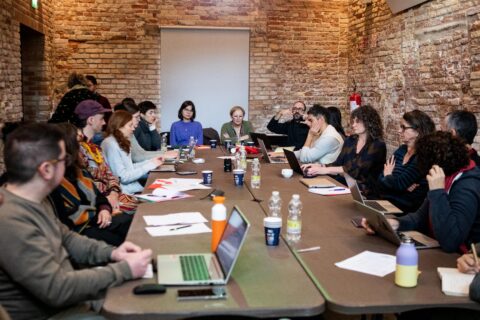First reflections from the Think Tank

© Barbara Rigon, Associazione Giochi Antichi
Over three intensive days in Venice (January 30 to February 1, 2025), the project partners, Think Tank members, and local community stakeholders came together to reflect on the complex yet enriching connection between living heritage and tourism. As the project moves into its next phase (defining the main problems to address and coming up with creative pilot studies), the Think Tank discussions highlighted crucial aspects for us to carry forward.
Sharing a common language: clarifying terms & intentions
A central challenge quickly became apparent: the worlds of tourism and intangible heritage safeguarding often speak different languages. The very words we use—like "product," "visitor," or "authenticity"—carry distinct meanings and associations in each context. Clarifying this terminology isn’t simply an academic exercise or semiotics; it is a crucial aspect of respectful engagement and mutual understanding.
As Noel Salazar succinctly pointed out:
“We keep using words like ‘tourists,’ ‘visitors,’ ‘public,’ and ‘people.’ We need to be more precise about who we are trying to connect with— it makes a difference.”
Wendy Raaphorst also stressed the importance of translating concepts to ensure understanding among heritage practitioners:
“You need to make a transfer also from the terminology and to bring it closer to them… you want to build a legacy and a toolkit also for other intangible heritage members.”
This clarity and accessibility help align intentions across stakeholders, preventing misunderstandings and fostering meaningful connections.

© Barbara Rigon, Associazione Giochi Antichi
Community at the heart: ownership & empowerment
Think Tank experts repeatedly emphasised that heritage practices need to remain firmly related to its practitioners. Tourism activities can support and strengthen heritage—but only so when the heritage communities retain authority and stewardship over how their practices are represented and experienced towards visitors.
Martín Andrade-Pérez reminded the meeting participants of the delicate balance between safeguarding traditions and introducing tourism tools. He argued that tourism has become an inevitable part of our societies and, with thoughtful collaboration, we can guide its development in ways that honour and support living heritage. Martín further stated that one of the key challenges to address is the differing of perspectives, as tourism focuses on creating experiences as “products.” At the same time, the heritage field is concerned with the safeguarding of cultural practices. We need to recognise these differences and co-create tools that can effectively bridge this gap in approaches:
“We need to build tools together.”
Martín advocated strongly for community empowerment, suggesting that the heritage practitioners and bearers themselves could ideally lead tourism operations related to their heritage, with external (tourism or other) experts supporting rather than leading:
“It should be sustainable for the communities themselves; they should be able to manage their heritage and become their own tourism operators—not as their main job, but as custodians who decide what to do.”
Governance & ethical engagement
Managing tourism ethically demands clear frameworks. Diego Rinallo brought forward practical advice, proposing operational guidelines that tourism businesses can easily follow to ensure respectful interaction with heritage communities:
“Guidelines for tourism operators should clearly outline how to approach living heritage communities respectfully. It needs to be operational, straightforward, easy to understand—like steps that guide tourism businesses clearly on involving communities and sharing benefits.”
Harriet Deacon underscored this, reflecting on the Sami community's established Ethical Guidelines for Tourism as potentially instructive models:
“The more specific the guidelines, the better leverage you get at that intersection between safeguarding, planning, and tourism.”

© Barbara Rigon, Associazione Giochi Antichi
Diego Rinallo furthermore warned for the risks when community-based codes of ethics are lacking:
“Sometimes community members are competitors… one gets approached by an agency, the other gets left out—this can creates animosity.”
Ethical engagement, therefore, must also include mechanisms for internal cohesion, not just external guidelines.
Beyond standard tourism: creating meaningful experiences
Diego Rinallo emphasised that living heritage tourism isn't about constant availability or mass commodification. Instead, it involves providing deeply personal and often exclusive (valuable) experiences that truly connect visitors with living heritage communities:
“Many tourists look for authenticity. The real value lies in providing visitors access to people representing the community. These encounters are priceless. You don't commodify this to be accessible 24/7—it's about privilege, authenticity, and meaningful connections.”
Such thoughtful design can prevent overtourism while maintaining the integrity and resilience of heritage practices.
Capacity building as a co-creation process
Rather than deliver pre-packaged training, Think Tank members championed co-created learning.
Martín Andrade-Pérez urged:
“We want to do it with the heritage community… not just imagine what they need, but listen together and then develop the capacity building. Some pilots might need different tools—that’s fine.”
Building flexible frameworks: from strategies to recipes
Rigid planning frameworks rarely fit the dynamic world of intangible heritage. Harriet Deacon introduced the compelling metaphor of the "Enchanted Broccoli Forest" (a cookbook by Molly Katzen), advocating for adaptable "recipes" rather than fixed strategies:
“We have a lot of ideas for individual safeguarding measures, but we need to talk more about strategies: how different measures can be combined together in a specific context to address problems and maximise benefits. It's a bit like cooking: the whole ends up being more than the parts. One of my favourite approaches to cooking is ‘The Enchanted Broccoli Forest’ by Molly Katzen. Instead of specific recipes, it gives you an approach to combining ingredients that provides for variability in taste (do you want a wholewheat base for the quiche or a potato base?), but explains what makes them work well together to make a good meal (e.g. a specific oven temperature, proportions of eggs and milk). We need to be more creative in thinking about how safeguarding measures are integrated into holistic strategies in tourism planning.”
Noël Salazar also emphasised the value of diversity within the project, cautioning against homogenising approaches:
“Don’t fall into the trap of trying to homogenise and come up with one-size-fits-all solutions. Use the richness of your diverse case studies to innovate.”

© Barbara Rigon, Associazione Giochi Antichi
Long-Term thinking: monitoring, evaluation, & community-led metrics
Evaluating success shouldn't rely solely on standardised measures imposed externally. Instead, Think Tank experts suggested involving communities directly in defining their metrics. Harriet Deacon argued for embedding monitoring into the communities' daily practices, making evaluations more meaningful and actionable:
“Community members themselves can collect data and observe impacts regularly. This helps them respond quickly and provides them leverage with tourism authorities.”
Diego Rinallo supported this, stressing community-defined goals as critical for meaningful evaluation:
“Metrics depend entirely on your goals. First, ask communities: how would you measure success? Find practical, community-oriented ways to measure this.”
Martín Andrade-Pérez added a practical proposal:
“Think about indicators related to consensus, participation, learning and transmission—that would be innovative.”
Influence & legacy: aligning pilot actions with policy
Leandro Peredo advised patience regarding policy influence, suggesting that successful pilot projects naturally create pathways towards broader policy impact:
“Right now, the pilots are about discovering common trends and contexts. Policy influence should follow naturally from successful, grounded pilots, not the other way around.”
He further advised practical steps to ensure pilot longevity:
“Aligning pilots' outcomes and new processes with existing frameworks—like periodic UNESCO reporting—can scale up your project's impact and legacy beyond the project duration.”

© Barbara Rigon, Associazione Giochi Antichi
Embracing complexity: diversity & discomfort as strengths
Finally, Think Tank experts highlighted the project's rich diversity as its greatest strength. Diego Rinallo encouraged embracing the inevitable discomfort that arises from cross-disciplinary work:
“Discomfort is normal when different worlds collide. Realising we must learn anew is very valuable. Continue this conversation; eventually, you'll begin to understand each other deeply.”
Harriet Deacon eloquently summarised this sentiment:
“This project is very exciting because you're embracing complexities that many shy away from. These questions are necessary, not easy, but profoundly important for the future of heritage and tourism.”
Not just 5 showcases
Looking ahead to 2025 and 2026, participants confirmed that pilot initiatives—whether in Venice, Kraków, Istria, Flanders, or Sweden—should become living, ongoing processes, not short-term experiments. As Jorijn (Workshop Intangible Heritage, Belgium) put it:
“Our task is not to make five wonderful projects to stick on a website, but rather to make five embedded long-term projects—a network that will stay after the project is finished.”